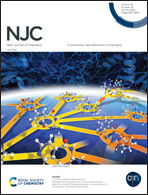Synthesis and dye adsorption studies of the {dibromo(1,1′-(1,2-ethanediyl)bis(3-methyl-imidazole-2-thione)dicopper(i)}n polymer and its conversion to CuO nanospheres for photocatalytic and antibacterial applications†
Abstract
A new imidazole-2-thione based copper coordination polymer namely [Cu2(ebit)Br2]n (1) [ebit = 1,1′-(1,2-ethanediyl)bis(3-methyl-imidazole-2-thione)] was synthesized by a layer diffusion method, and [(C10H14N4S)CuBr3] (2) was a by-product of 1 and was obtained through redox processes between the ligand and metal ion. Polymer 1 was fully characterized by IR, CHNS, PL, TGA, PXRD and single crystal X-ray diffraction analysis. In polymer 1, the copper atom is coordinated by two bridging bromides and two sulfur atoms from two ebit ligands with a distorted tetrahedral geometry to form a 2D honeycomb network, while in 2, the copper atom is coordinated only by three bromide atoms to create the anionic part of the compound and stabilized by the cationic moiety of the ligand. Both compounds have expanded into 3D networks through intermolecular interactions. The adsorption ability of polymer 1 toward four dyes namely Congo Red (CR), Aniline Blue (AB), Malachite Green (MG) and Victoria Blue (VB) was investigated and the results indicated that the title polymer has excellent adsorption capacity towards these dyes. Adsorption kinetics and isotherms and the adsorption mechanism were also analyzed. Polymer 1 was converted to nanospheres 1 by an ultrasonic method and used as a precursor for the preparation of CuO nanospheres. The obtained metal oxide was characterized by SEM, TEM, EDX, PXRD and IR. The results of photocatalytic and antimicrobial tests revealed that the CuO nanospheres showed good performances for the degradation of Rhodamine B and good antibacterial activity.



 Please wait while we load your content...
Please wait while we load your content...